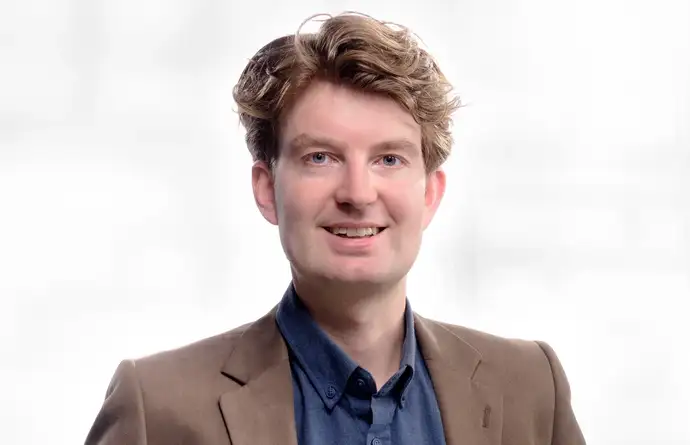Technology meets aesthetics
Strong, durable, and highly resistant to corrosion, glass is also sustainable and completely recyclable. Working with Prof. Rob Nijsse, Ate Snijder and their team have worked with glass on three separate outdoor projects: a glass bridge, a glass swing, and a Ziptruss, an exceptional construction that shows the hidden compression and tension forces in a structure.
In a revealing interview, Ate Snijder explains why glass was chosen as the main construction material for these projects and why he partnered with SCHOTT for their materials and expertise.

How did the idea of using glass come about?
We wanted to attempt to bridge the disparity between glass art and architectural glass, because little synergy exists between these two fields. Glass art can be sculptural, curvaceous and spectacular, whereas architectural glass tends to be structural, flat, and almost invisible. Three engineers and educators with a passion for structural design, Prof. ir. Rob Nijsse, Ir. Lennert van der Linden, and myself often fantasize about and realize ways to do more with glass as a structural material. Our question is: Can the fields of architectural glass and glass art merge to create structures with the qualities of glass art, addressing form, light, playfulness, elegance and function?
Why did you choose glass as a building material?
Originally we thought of a steel structure, but that’s nothing new. We wanted the structures to have a certain aesthetic. Glass has several advantages: it’s very strong and durable. A glass construction also means virtually no maintenance because it neither rusts, corrodes or rots. On top of that, glass is affordable. Calculations and digital simulations finally showed that implementing our ideas were actually possible. The fact that using glass as a construction material is still relatively new and hardly researched was one more reason for us as scientists to use the material.
What were your biggest challenges with these projects?
When we started with the glass bridge, we connected star-shaped CONTURAX® glass tubes and six round DURAN® glass tubes, with a transparent UV adhesive holding the tubes together. By making a bundle rather than a single glass rod, we create redundancy. If one or even two or three rods in the bundle fail, the bundle as a whole still retains some load-bearing capacity.
For our next project, the glass swing, we wanted to find an optimal but beautiful glass structure that relied on post tension rather than adhesive to add strength to the construction. To create a stable and efficient load-bearing frame of glass bundle bars, my colleague Lennert van der Linden and I used computer-aided parametric design techniques. We knew the technology behind creating safe glass bundle bars, but the required structural nodes to connect the bundle bars had to be developed.
Inspired by these projects, we then wanted to make the forces impacting a glass construction visible. Forces acting in structures cannot be observed, but the Ziptruss makes these forces visible in a spectacular way, with the structural members lighting up to show the compression and tension forces in real time. The rail with the seat allows the visitor to apply a force – their own weight – to the structure and move that force along the length of the beam, which results in a dynamic pattern of forces with a big visual impact.
The Ziptruss is a perfect example of how the Delft University of Technology can take an idea and turn it into a fully functional construction. Its success, along with our other glass structures, means that we are now actively seeking industry partners for new projects, using our knowledge and experience to take on bigger challenges. We believe that glass offers a unique set of properties that makes it ideal for a wide range of constructions.
What have you learnt from the projects?
For the glass bridge, we worked with glass rod bundles, which proved to be very strong in compression compared to steel or concrete. Bundles of glass are safe for use in structures because of their redundancy, so they can take some damage without failing completely. By applying a compressive force on the glass, or pre-stressing the bundle, we can make sure that the glass always under compression, even if the bundle is loaded by a tension force. But the bundles’ most important quality is their incredible esthetics. To further optimize the glass bundles, we will test different configurations with and without glue.
The glass swing showed that we can combine architecture and art to produce a playful construction that utilizes the enormous aesthetic potential of glass, while at the same time creating a strong, safe and functional object.
For the Ziptruss, we took advantage of the new product DURAN® Tough, with its transparent inner polymer coating. Making the forces visible was a real highlight which will lead us to new projects, and we are looking forward to sharing our knowledge with other teams working on similar projects.
What makes glass special as a construction material?
The most challenging aspect is that you cannot hide anything. People can see right into the material and any bad detailing or damage is immediately visible. The trick is to keep the construction very clean and very simple. Secondly, there are big structural challenges: The structure must be safe, vandalism-proof like DURAN® Tough, and stresses in the glass must be controlled carefully. Glass is not a very forgiving material in its use in construction. Fortunately, we have an enormous amount of accumulated knowledge and experience here at the university on how to engineer glass structures.
Did your experiences with glass motivate you to use it again?
No doubt. Every project brings great satisfaction, but also a gnawing regret about all the things that could have been done better. A new project offers the opportunity to use the lessons learnt. This finally brought us to the Ziptruss project, which is the beginning of a new kind of construction.
What was working with SCHOTT like?
SCHOTT has proven to be a great supplier throughout these projects. We’re more than satisfied with the quality of the glass rods, tubes, and the service. We hope to keep our relationship open and work together in the future because we already have some exciting projects in mind.
DURAN® is a registered trademark of the DWK Life Sciences GmbH.
February 18, 2022
Links
More about art installations and glass constructions
More about designing objects, buildings, and bridges using glass
Team Credits
The success of the glass bridge, glass swing, and Ziptruss projects was due to the expertise and hard work of a large number of people. Those people are:
Glass Truss Bridge: Ate Snijder (TU Delft, G&SS), Kees Baardolf (TU Delft), Rob Nijsse (TU Delft, G&SS), Lourens Broeks (Wacky Tec), WanYun Alice Huang (TU Delft), Eli Padmos (Konvooi Exceptioneel).
Glass Swing: Ate Snijder (TU Delft, G&SS), Lennert van der Linden (TU Delft, Arup), Rob Nijsse (TU Delft, G&SS), Tolga Ozdemir (TU Delft), Lourens Broeks (Wacky Tec), Kees Baardolf (TU Delft), Christian Louter (TU Delft), WanYun Alice Huang (TU Delft), Vincent Wegener (Ramlab), Robert Capel (Octatube), Tommaso Venturini (TU Delft).
Ziptruss: Ate Snijder (TU Delft, G&SS), Rob Nijsse (TU Delft, G&SS), Koen Bakker (TU Delft), Nicoleta Sidiropoulou (TU Delft), Sander van Rosmalen (TU Delft), Nikol Dimitriou (TU Delft), Robert Capel (Octatube), Wouter Verhoeven (Proliad), Anjo Kuiper (De Cirkel), Peter Eigenraam (TU Delft, Eigenraam, Engineering), Mauro Overend (TU Delft), Rik Kwakman (TU Delft), Jornt Bieze (TU Delft), Tjeu Peeters (TU Delft), Joep Knuppe (TU Delft), Coen van der Werf (TU Delft), Helene Bouwmeester (TU Delft), Hilde van de Pol (TU Delft).


